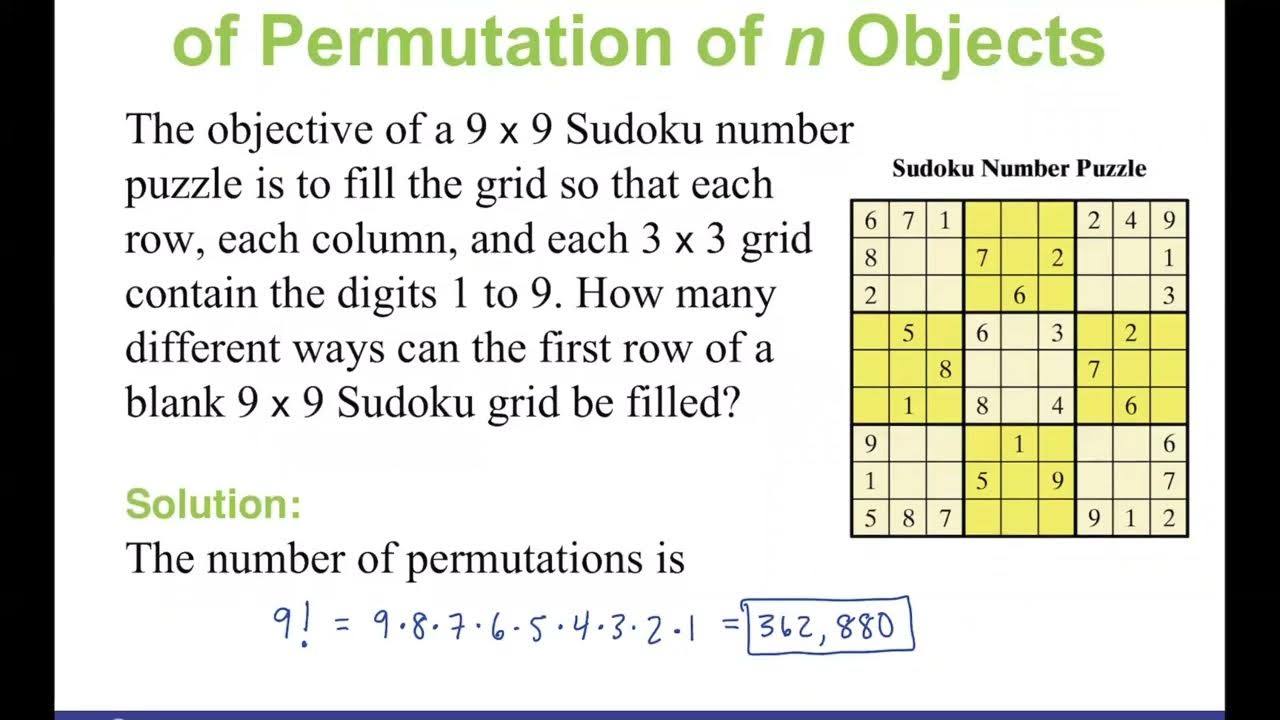Peluang Matematika Bagian 1
Summary
TLDRThis video lesson provides an in-depth exploration of basic counting principles in mathematics, focusing on probability, permutations, combinations, and other counting techniques. The instructor explains various real-life examples of how to calculate possible outcomes, including how to arrange digits to form numbers under certain conditions and the importance of logical reasoning over memorized formulas. The lesson covers topics like arranging people, forming numbers with specific constraints, and solving problems related to division rules like divisibility by 5 or generating even numbers. Students are encouraged to use simple multiplication rules and logical thinking to solve these counting problems.
Takeaways
- 😀 The concept of kaidah pencacahan (counting principles) is a fundamental concept in mathematics, especially when working with probabilities and arrangements.
- 😀 Counting problems are often solved using logical reasoning and multiplication rules rather than specific formulas.
- 😀 For example, when arranging four-digit numbers between 2000 and 6000 using certain digits, you can calculate possibilities by considering each position and applying multiplication.
- 😀 In cases where repeated digits are allowed, such as creating numbers from a set of digits with no restrictions on repetition, multiplication of possibilities for each position gives the total number of arrangements.
- 😀 When solving problems where numbers must meet certain constraints (e.g., less than 450 or more than 3000), it's crucial to break down the problem into smaller cases based on the provided limits.
- 😀 The approach for arranging numbers also considers constraints like even or odd numbers, such as ensuring the last digit is even for generating even numbers.
- 😀 Some problems, like arranging three-digit even numbers from a given set of digits, require handling restrictions like no repeated digits, and considering specific constraints like the last digit being even.
- 😀 For problems involving divisibility (e.g., numbers divisible by 5), it's essential to focus on the last digit (which must be either 0 or 5), and calculate the total number of valid possibilities.
- 😀 Counting problems involving multiple steps, such as a person traveling between cities using different bus routes, are solved by multiplying the number of choices at each stage of the journey.
- 😀 Logic and reasoning are key in many real-world counting problems, such as seating arrangements where some individuals must sit together, while others must not, highlighting the importance of breaking down the problem step by step.
Q & A
What is the main topic discussed in the script?
-The script primarily discusses mathematical concepts related to probability and counting principles, particularly focusing on 'kaidah pencacahan' (counting rules) in mathematics.
How does the script describe kaidah pencacahan (counting rules)?
-Kaidah pencacahan, or counting rules, refers to methods used to determine the number of ways to arrange or organize things under specific conditions, often through logical reasoning rather than formula-based calculations.
What example is given to demonstrate kaidah pencacahan?
-An example provided involves determining how many three-digit numbers divisible by 5 can be formed using the digits 0, 1, 2, 3, 4, and 5, with the condition that the digits are distinct.
What are the two types of counting methods discussed in the script?
-The script mentions the use of multiplication rules (such as for determining possible outcomes by multiplying the number of choices for each position) and logical reasoning to solve counting problems.
What is the significance of the numbers between 2000 and 6000 in the script?
-The script explains how to form numbers between 2000 and 6000 using digits from 0 to 7. The rules involve selecting a digit for each place in the four-digit number, with specific restrictions on the thousands place.
How are numbers smaller than 450 calculated in the example given?
-The script breaks down the problem by looking for numbers less than 450. For this, the hundreds digit must be either 2 or 3, and then other digits are selected without repetition, resulting in several possibilities.
How does the script handle the problem of calculating even numbers?
-The script first determines that an even number must end with an even digit (0, 2, 6, or 8) and considers the restrictions such as no repetition of digits, explaining how to calculate the number of possibilities for such numbers.
What principle is used to calculate the number of ways to arrange 8 people at computers?
-The principle of counting is applied by calculating the number of possible ways the 8 people can be assigned to 3 available computers, using multiplication to find all combinations.
What is the key concept behind the arrangement of debate finalists in the script?
-The concept is that one finalist must be placed in the middle of the lineup, reducing the problem to arranging the remaining 6 finalists, which can be done in 6! (720) ways.
How are the travel options between cities A, B, and C calculated in the script?
-The calculation involves determining the number of different travel routes from city A to C via B, considering that the person cannot take the same bus on the return journey from C to A, reducing the number of options for the return trip.
Outlines

This section is available to paid users only. Please upgrade to access this part.
Upgrade NowMindmap

This section is available to paid users only. Please upgrade to access this part.
Upgrade NowKeywords

This section is available to paid users only. Please upgrade to access this part.
Upgrade NowHighlights

This section is available to paid users only. Please upgrade to access this part.
Upgrade NowTranscripts

This section is available to paid users only. Please upgrade to access this part.
Upgrade NowBrowse More Related Video

Kaidah Pencacahan, aturan penjumlahan, aturan perkalian, filling slot mudah dan gampang dipahami.

How to do Questions of fundamental principle of counting|permutations combinations|BBA Maths|BCAMath

Math 119, 4.4 Lecture Video

Math 123 - Elementary Statistics - Lecture 12

Kaidah Pencacahan 3 - Permutasi dan Kombinasi Matematika Wajib Kelas 12

Permutations, Combinations & Probability (14 Word Problems)
5.0 / 5 (0 votes)